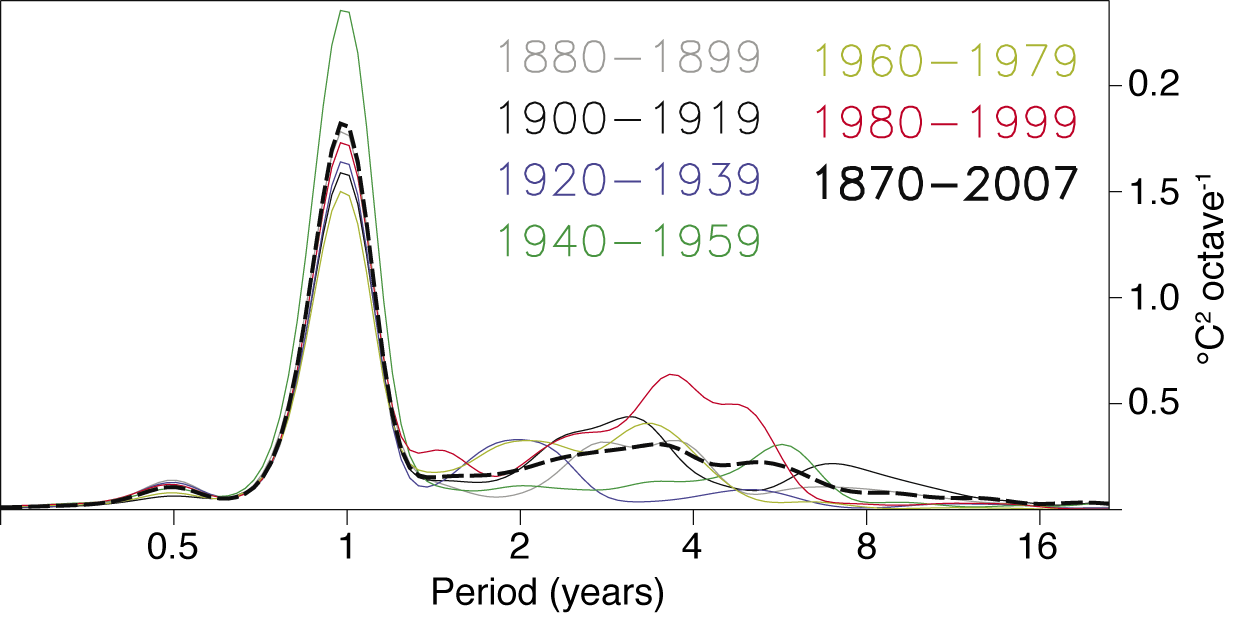- Home
- Publications
- PAGES Magazine
- El Niño-Southern Oscillation - What Is The Outlook For ENSO? [Present]
El Niño-Southern Oscillation - What is the outlook for ENSO? [Present]
Amy Clement
PAGES news
20(1)
28
2012
Amy Clement
Rosenstiel School of Marine and Atmospheric Science, University of Miami, USA; aclement rsmas.miami.edu
rsmas.miami.edu
Climate variability in the tropical Pacific is dominated by the El Niño/Southern Oscillation (ENSO), which has global impacts, most notably in drought-prone regions such as the southwestern USA and Australia. How will the tropical Pacific fluctuate in the coming decades to century? A first-order answer from both paleoclimate records and climate models is that the Pacific will continue to be characterized by large seasonal and interannual variability during the coming century. Seasonally resolved tropical-Pacific paleoclimate records from periods in the Earth’s history that were both warmer and colder than today point to interannual variability (Watanabe et al. 2011; Scroxton et al. 2011; Koutavas and Joanidis 2009; Tudhope et al. 2001). And models too have thus far not been able to rid the tropical Pacific of ENSO variability by either warming (Huber and Caballero 2003; Galeotti et al 2010; von der Heydt et al. 2011) or cooling the climate (Zheng et al. 2008).
This result may seem somewhat surprising given our textbook understanding of ENSO. One might conclude that the positive Bjerknes feedback between the winds, surface temperature gradient and thermocline on the equator would cause the Pacific to run away to one state or another, resulting in what is referred to in the literature as a “permanent El Niño” state. However, a recent analysis by DiNezio et al. (unpublished data) of model simulations of the climate response to doubled CO2 shows that this does not happen because the winds and thermocline actually have opposing effects on ENSO. A warming climate would, on its own, weaken the Walker circulation and hence reduce ENSO variability. However, weaker trade winds would result in a less tilted but shallower thermocline, which would strengthen ENSO variability. These competing effects probably explain some changes in the past too. So it seems that ENSO is here to stay.
There are of course a number of other higher-order and important questions about the tropical Pacific that are still wide open. For example, can ENSO have long periods of quiescence? What causes decadal and multidecadal variability in the tropical Pacific? Are these behaviors of the tropical Pacific predictable on seasonal, interannual and decadal timescales? Are they influenced by greenhouse-gas forcing?
Limitations of the instrumental record do not allow us to fully address the question of decadal variability in the Pacific (Fig. 1). Annually resolved paleoclimate proxies are key to filling in the low-frequency part of the spectrum. Some paleoclimate proxies suggested that the Pacific climate has natural variability on timescales of centuries and even millenia (T. Ault, pers. comm.). We do not yet know of an appropriate mechanism, though feedbacks involving low-level clouds, among others, have been invoked (Clement et al. 2011). Current climate models, being deficient in their representation of low-level clouds (Clement et al. 2009), might not simulate Pacific decadal variability properly. Detection and attribution of anthropogenic change in the tropical Pacific may thus remain an extremely challenging problem for the foreseeable future.
As to predictability, one of the great achievements in the late 20th century was the development of a monitoring and prediction system that can predict ENSO a season in advance. However, despite improving modeling capabilities and increased observations over the past two decades, our predictive skill has not improved significantly. Further, there is now an ongoing international effort coordinated through the Coupled Model Intercomparison Project 5 (CMIP5) to attempt to make decadal or so-called “near-term” climate predictions. But our confidence in these prediction systems is limited by our ability to put them to the test of hindcasting past climate fluctuations. Here again, the observation record is simply too short, and the only way around this is to extend the record further back in time with paleoclimate data.
Of course, paleoclimate data are always going to be sparse, but it has been shown that predictions can be made with a relatively few set of the modes (e.g. Kirtman and Schopf 1998). It is encouraging that only a few records from key places in the Pacific over the last several centuries can provide a means to answering the questions about how the tropical Pacific climate will vary during the coming century.
selected references
Full reference list online under: http://pastglobalchanges.org/products/newsletters/ref2012_1.pdf
Clement AC, DiNezio P and Deser C (2011) Journal of Climate 24: 4056-4072
Huber M and Caballero R (2003) Science 299: 877-881
Scroxton N et al. (2011) Paleoceanography 26, doi: 10.1029/2010PA002097
Watanabe et al (2011) Nature 471: 209-211
Wittenberg AT (2009) Geophysical Research Letters 36, doi: 10.1029/2009GL038710
